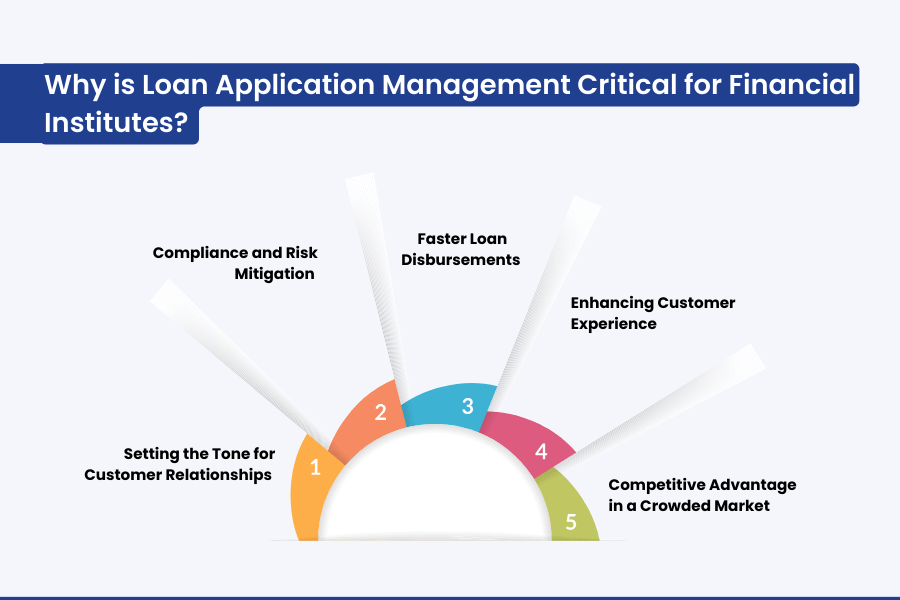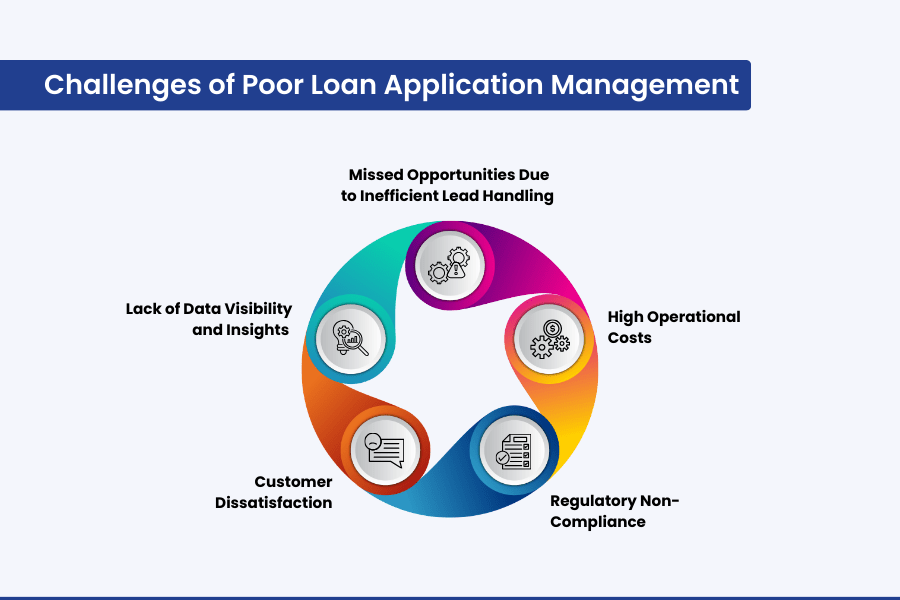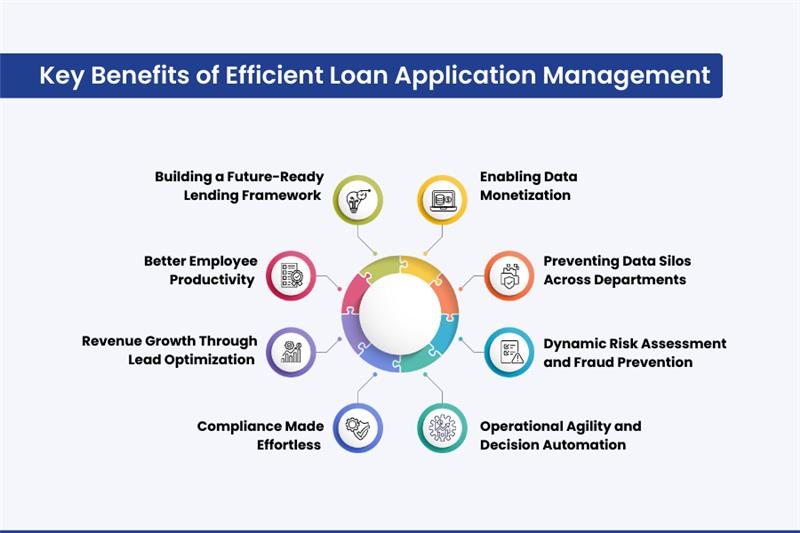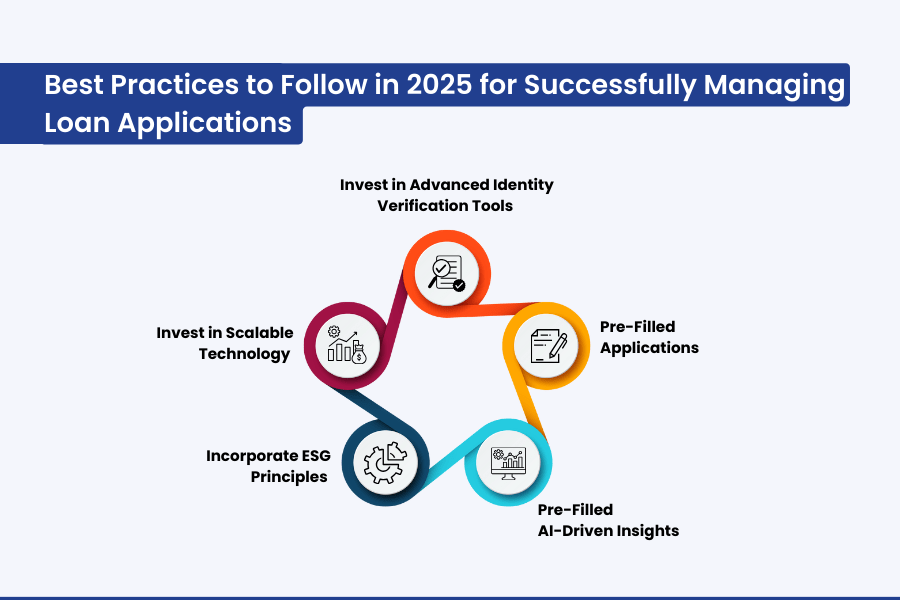
The success or failure of any organization hinges on numerous factors, but none are as pivotal as management—the backbone of operational excellence. For financial institutions, effective management is crucial to survive and grow. Precision in handling tasks, swift data accessibility, and delivering seamless customer experiences are hallmarks of successful management.
When it comes to lending, management of loan applications is crucial – as it forms the foundation for efficient lending operations from applicant onboarding to loan disbursement. Financial institutes that optimize and streamline loan applications experience a faster and customer-centric lending process with minimum risks and operational costs.
In this blog, we’ll explore Loan Application Management in detail—its key benefits, and best practices that NBFCs must adopt to stay competitive in 2025.
- Why is Loan Application Management Critical for Financial Institutes?
- Challenges of Poor Loan Application Management
- Key Benefits of Efficient Loan Application Management
- Pro Insight:
- Best Practices to Follow in 2025 for Successfully Managing Loan Applications
- How lendmantra Can Transform Loan Application Management?
- Future-Proof Your Loan Application Management
- Frequently Asked Questions
Why is Loan Application Management Critical for Financial Institutes?

1. Setting the Tone for Customer Relationships
Delays or errors can frustrate potential borrowers, resulting in lost opportunities or negative reviews. An optimized loan or system process reduces redundancies, eliminates manual errors, and accelerates approvals, creating a positive all-time experience.
2. Compliance and Risk Mitigation
Operating in a highly regulated environment, financial institutions must ensure adherence to compliance and regulatory frameworks. Improper management can lead to inaccuracy, incomplete records, overlooked details, and non-compliance. Therefore proper management rights from applications ensure compliance, and accuracy and maintain auditable records.
Tip: Many financial institutions (most probably your direct competitors) have started integrating lending management software system that comes with AI-powered efficiency and features such as task management, credit processing applications, and rules-based engines. This minimizes the risk of non-compliance, approving unqualified applicants, or fraudulent cases.
Get Started with lendmantra
lendmantra is a reliable and result-driven lending management suite for all your loan origination and management needs.
3. Faster Loan Disbursements
With automated loan management software, loan processing times can be reduced drastically. By leveraging tools like rules and scorecard engines and API integration middleware, NBFCs can enhance decision-making and minimize delays.
4. Enhancing Customer Experience
Modern customers expect quick decisions and personalized services. Loan application management assists financial institutes in assessing customer data in real-time, making data-driven decisions, assessing credit faster, and approving or disapproving quickly and accurately.
5. Competitive Advantage in a Crowded Market
You cannot win merely because of your offerings, your ability to deliver quickly, seamlessly, and with quality services is what stands you out from your competitors. This is what the application management process allows financial institutions to deliver to their customers. This not only satisfies customers but also retains, attracts, and gives a competitive advantage.
Challenges of Poor Loan Application Management

1. Missed Opportunities Due to Inefficient Lead Handling
Without robust sales pipeline management and lead management solutions, promising leads can slip through the cracks. Disorganized workflows result in high customer churn rates and lost revenue.
2. High Operational Costs
Manual processes increase overheads and are prone to errors. For instance, relying on spreadsheets or outdated systems for loan application tracking slows down credit processing and impacts profitability.
3. Regulatory Non-Compliance
Failing to maintain proper records or activity logs can expose NBFCs to legal and financial risks. Effective master data management and activity timeline tracking are essential to remain audit-ready.
4. Customer Dissatisfaction
Applicants expect quick decisions and transparency. A poorly managed system can lead to longer wait times, repeated documentation requests, and dissatisfied borrowers.
5. Lack of Data Visibility and Insights
Disorganized loan application management prevents institutions from accessing real-time insights into application statuses, customer profiles, and workflow efficiency. Without these insights, decision-making becomes slower and less informed, reducing the overall efficiency of the lending process.
Key Benefits of Efficient Loan Application Management

1. Building a Future-Ready Lending Framework
In today’s digital era, customers expect instant gratification. Efficient loan application management helps financial institutes keep pace with evolving customer expectations while positioning themselves for future trends.
2. Enabling Data Monetization
With proper application management, NBFCs can analyze borrower trends, behavior, and repayment patterns too. These insights are invaluable for developing new lending products or even monetizing data partnerships, turning a traditionally operational process into a revenue stream.
3. Preventing Data Silos Across Departments
Unorganized processes and a lack of application management often lead to fragmented data stored in silos, making collaboration and decision-making challenging. A well-managed application makes customer information accessible, ensuring activity timeline tracking and cross-department collaboration for faster approvals.
4. Dynamic Risk Assessment and Fraud Prevention
Management of loan applications in a systematic way flags anomalies, such as incomplete documents or inconsistent financial details, in real time. This allows financial institutions to act proactively, reducing fraud risks and minimizing the approval of high-risk borrowers.
5. Operational Agility and Decision Automation
Loan application management isn’t just about speed—it’s about making informed decisions faster. By making application management a crucial part of lending operations and integrating task management software with real-time data analytics, institutes can allocate tasks efficiently and automate approval workflows, minimizing bottlenecks.
6. Compliance Made Effortless
Efficient loan application management ensures adherence to RBI guidelines and regulatory frameworks by automating compliance checks. Features in lending management suits such as auditable records and real-time document verification reduce the risk of non-compliance and hefty penalties.
7. Revenue Growth Through Lead Optimization
Loan application systems integrated with lead management solutions help NBFCs maximize conversion rates. By tracking every stage of the sales pipeline, they can identify and nurture high-potential leads, boosting revenue without increasing costs.
8. Better Employee Productivity
Lack of management burdens employees with repetitive tasks, limiting their ability to focus on strategic objectives. Proper management specifically application management may look hectic and time-consuming at the start. However, it is actually a boon – in terms of freeing up resources, giving clarity, and redirecting efforts toward areas like customer acquisition or risk analysis.
9. Ensuring Transparency for Borrowers
Customers often lose trust in lenders due to unclear or opaque processes. Loan application management systems provide borrowers with status updates, clear communication, and detailed timelines, ensuring transparency throughout the process.
Pro Insight:
Invest in a scalable loan origination system with built-in API integration middleware to future-proof your operations. Such systems not only optimize lending processes but also enable swift adaptation to market demands and future advancements.
Best Practices to Follow in 2025 for Successfully Managing Loan Applications

1. Invest in Advanced Identity Verification Tools
Increasing mandates like Companies House transparency reforms have made identity verification pivotal. Investing in biometric verification and KYC checks can ensure the authenticity of an applicant’s identity and thus reduce the risk of fraud.
2. Pre-Filled Applications:
Use open banking APIs to auto-fill financial data for applicants, reducing manual entry and errors.
3. AI-Driven Insights
Implement predictive analytics to assess an applicant’s creditworthiness using real-time financial data.
4. Incorporate ESG Principles
Meet the growing demand for sustainable practices right from the beginning. Create fast-track systems for applications that align with ESG criteria. Build frameworks to evaluate borrowers’ environmental and social practices, especially for corporate loans.
5. Invest in Scalable Technology
As NBFCs grow, their systems should scale with them. Choose a loan management software that offers flexibility to add new workflows, integrate with advanced tools, and customize processes as needed.
How lendmantra Can Transform Loan Application Management?
At lendmantra, we understand the unique challenges faced by NBFCs in managing loan applications. Our advanced loan origination system (LOS) is designed to:
- Automate key processes like loan application tracking and credit evaluation.
- Enable seamless integration with third-party APIs for real-time data fetching.
- Provide real-time dashboards for end-to-end visibility.
- Support flexible workflows tailored to your business needs.
With features like master data management, disbursement management systems, and customizable rules and scorecard engines, lendmantra ensures that every application is processed with speed, accuracy, and compliance.
Future-Proof Your Loan Application Management
Effective loan application management is no longer optional—it’s a necessity. By adopting best practices and leveraging advanced tools, you can not only streamline application management but also make things a lot easier for stakeholders.
If you have not yet started with loan application management or loan management your current system does not necessarily offer effective management features. Then transform the same in 2025 with lendmantra. Contact us today to explore how lendmantra can help.
Read More: https://lendmantra.com/blog/
Frequently Asked Questions
How can Loan application management software benefit financial institutions?
Loan application management, whether manual or automated, benefits financial institutions by increasing efficiency, reducing errors, enhancing data accessibility, and improving customer experience. However, with loan application management, these tasks are automated, verified digitally, fetch customer data itself, and provide updates and transparency.
How does loan application management software work?
Loan application management software automates and centralizes the entire loan application process. It typically works as follows:
- Data Collection: Salespersons or customers input required data and documents directly into the software.
- Verification & Assessment: The software verifies the uploaded data and assesses the applicant's creditworthiness.
- Review & Decision: Reviewers may request additional documents, and approve, or reject the application based on predefined criteria.
- Sanction Letter Generation: Upon approval, a sanction letter is issued containing loan details, terms, repayment schedules, and conditions.
What are the key features of Loan application management software?
Loan application management system features differ from software to software but in general, it includes:
- Task management
- Digital onboarding
- Lead management
- Application management
- Report generation
- Workflow automation tools
- Risk assessment tools
- Compliance management tools
Further advanced platforms such as lendmantra integrate AI, cloud computing, and automation to offer enhanced customization options and add-ons, boosting functionality and adaptability.
Is Loan application management software customizable for different loan types?
Yes, most of the loan application management software is highly customizable to incorporate varying loan types and business needs. Additionally, customization enables:
- Incorporating unique frameworks for different loans, such as personal, mortgage, or business loans.
- Seamless integration with third-party applications like CRM or risk assessment tools.
- Adding tailored workflows, document requirements, and compliance checks.



